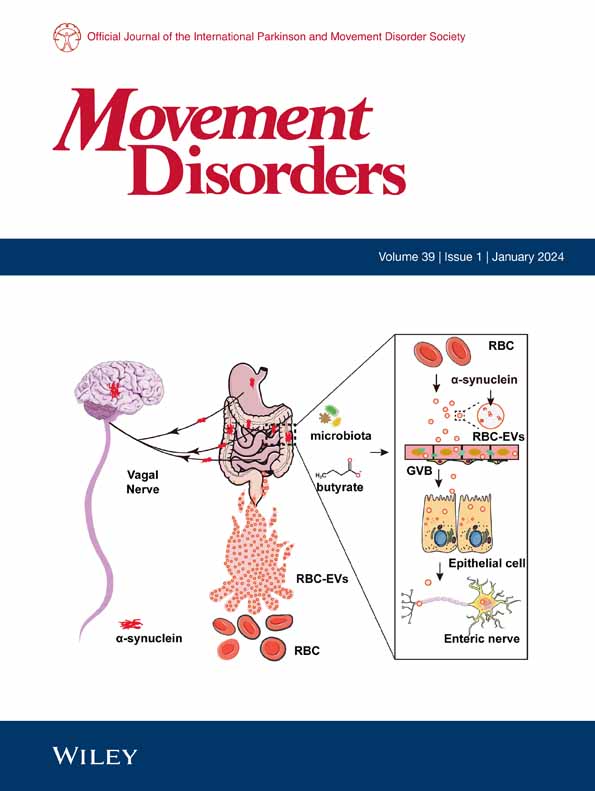Classification and Genotype-Phenotype Relationships of GBA1 Variants: MDSGene Systematic Review.
Malco Rossi, Susen Schaake, Tatiana Usnich, Josephine Boehm, Nina Steffen, Nathalie Schell, Clara Krüger, Tuğçe Gül-Demirkale, Natascha Bahr, Teresa Kleinz, Harutyun Madoev, Björn-Hergen Laabs, Ziv Gan-Or, Roy N Alcalay, Katja Lohmann, Christine Klein
求助PDF
{"title":"Classification and Genotype-Phenotype Relationships of GBA1 Variants: MDSGene Systematic Review.","authors":"Malco Rossi, Susen Schaake, Tatiana Usnich, Josephine Boehm, Nina Steffen, Nathalie Schell, Clara Krüger, Tuğçe Gül-Demirkale, Natascha Bahr, Teresa Kleinz, Harutyun Madoev, Björn-Hergen Laabs, Ziv Gan-Or, Roy N Alcalay, Katja Lohmann, Christine Klein","doi":"10.1002/mds.30141","DOIUrl":null,"url":null,"abstract":"<p><p>Depending on zygosity and the specific change, different variants in the GBA1 gene can cause Parkinson's disease (PD, PARK-GBA1) with reduced penetrance, act as genetic risk factors for PD or parkinsonism, and/or lead to Gaucher's disease (GD). This MDSGene systematic literature review covers 27,963 patients carrying GBA1 variants from 1082 publications with 794 variants, including 13,342 patients with PD or other forms of parkinsonism. It provides a comprehensive overview of demographic, clinical, and genetic findings from an ethnically diverse sample originating from 82 countries across five continents. The most frequent pathogenic or likely pathogenic variants were \"N409S\" (aka \"N370S\"; dominating among Jewish and Whites), and \"L483P\" (aka \"L444P\"; dominating among Asians and Hispanics), whereas the most common coding risk variants were \"E365K\" (E326K), and \"T408M\" (T369M) (both common among Whites). A novel finding is that early-onset PD patients were predominantly of Asian ethnicity, whereas late-onset PD patients were mainly of White ethnicity. Motor cardinal features were similar between PD patients and other forms of parkinsonism, whereas motor complications and non-motor symptoms were more frequently reported in PD patients carrying \"severe\" variants than in those with \"risk\" or \"mild\" variants. Cognitive decline was reported in most patients after surgical treatment, despite achieving a beneficial motor function response. Most GD patients developing PD harbored the \"N409S\" variant, were of Ashkenazi Jewish ethnicity, and showed a positive response to chronic levodopa treatment. With this review, we start to fill the gaps regarding genotype-phenotype correlations in GBA1 variant carriers, especially concerning PD. © 2025 The Author(s). Movement Disorders published by Wiley Periodicals LLC on behalf of International Parkinson and Movement Disorder Society.</p>","PeriodicalId":213,"journal":{"name":"Movement Disorders","volume":" ","pages":""},"PeriodicalIF":7.4000,"publicationDate":"2025-02-10","publicationTypes":"Journal Article","fieldsOfStudy":null,"isOpenAccess":false,"openAccessPdf":"","citationCount":"0","resultStr":null,"platform":"Semanticscholar","paperid":null,"PeriodicalName":"Movement Disorders","FirstCategoryId":"3","ListUrlMain":"https://doi.org/10.1002/mds.30141","RegionNum":1,"RegionCategory":"医学","ArticlePicture":[],"TitleCN":null,"AbstractTextCN":null,"PMCID":null,"EPubDate":"","PubModel":"","JCR":"Q1","JCRName":"CLINICAL NEUROLOGY","Score":null,"Total":0}
引用次数: 0
引用
批量引用
Abstract
Depending on zygosity and the specific change, different variants in the GBA1 gene can cause Parkinson's disease (PD, PARK-GBA1) with reduced penetrance, act as genetic risk factors for PD or parkinsonism, and/or lead to Gaucher's disease (GD). This MDSGene systematic literature review covers 27,963 patients carrying GBA1 variants from 1082 publications with 794 variants, including 13,342 patients with PD or other forms of parkinsonism. It provides a comprehensive overview of demographic, clinical, and genetic findings from an ethnically diverse sample originating from 82 countries across five continents. The most frequent pathogenic or likely pathogenic variants were "N409S" (aka "N370S"; dominating among Jewish and Whites), and "L483P" (aka "L444P"; dominating among Asians and Hispanics), whereas the most common coding risk variants were "E365K" (E326K), and "T408M" (T369M) (both common among Whites). A novel finding is that early-onset PD patients were predominantly of Asian ethnicity, whereas late-onset PD patients were mainly of White ethnicity. Motor cardinal features were similar between PD patients and other forms of parkinsonism, whereas motor complications and non-motor symptoms were more frequently reported in PD patients carrying "severe" variants than in those with "risk" or "mild" variants. Cognitive decline was reported in most patients after surgical treatment, despite achieving a beneficial motor function response. Most GD patients developing PD harbored the "N409S" variant, were of Ashkenazi Jewish ethnicity, and showed a positive response to chronic levodopa treatment. With this review, we start to fill the gaps regarding genotype-phenotype correlations in GBA1 variant carriers, especially concerning PD. © 2025 The Author(s). Movement Disorders published by Wiley Periodicals LLC on behalf of International Parkinson and Movement Disorder Society.


